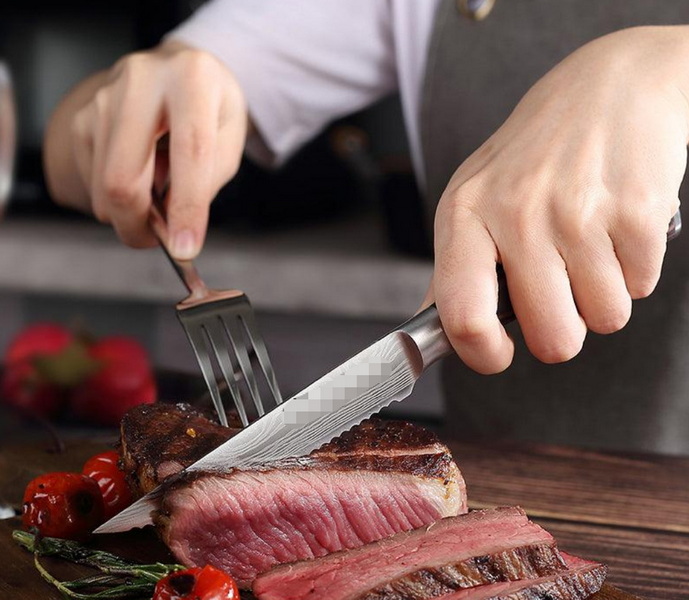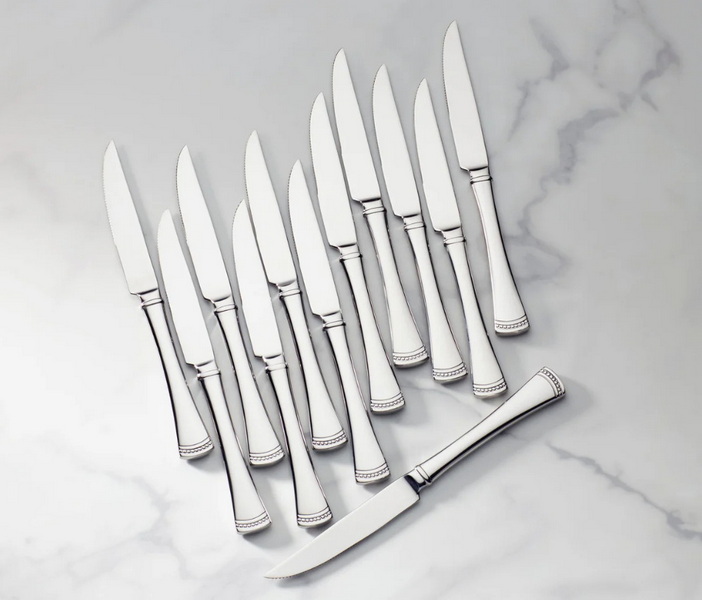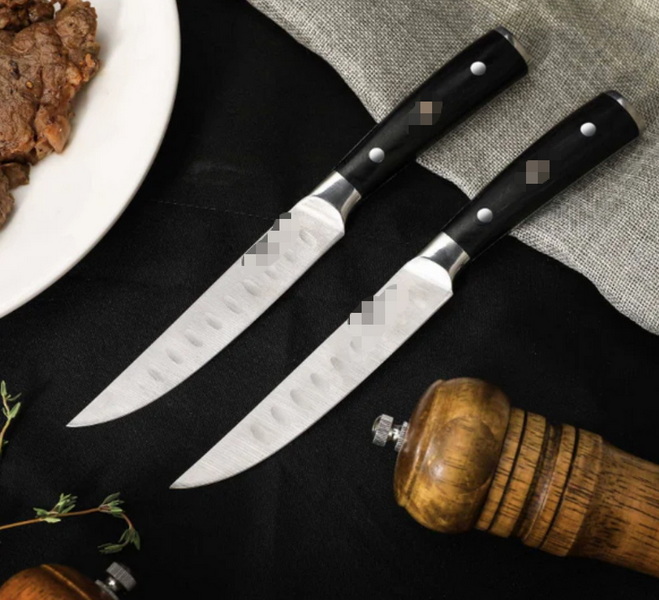- All
- Product Name
- Product Keyword
- Product Model
- Product Summary
- Product Description
- Multi Field Search
Views: 222 Author: Ann Publish Time: 2025-10-28 Origin: Site











Content Menu
● 1: Understanding Steak Knife Design
● 2: Essential Features for Pro Chefs
● 3: Home Kitchen Considerations
● 4: Material Science Behind Steak Knife Sets
● 5: OEM Partnerships: From China to Global Brands
● 6: Buying Guide: Matching Steak Knife Sets to Needs
● 8: Design Trends and Innovations in 2025
● FAQ
>> What is the ideal blade material for a steak knife set?
>> How often should steak knives be sharpened?
>> What blade angle is best for steak knives?
>> Are Damascus-style blades worth the extra cost?
>> How should I care for wooden-handled steak knives?
In professional kitchens and bustling home settings alike, a reliable steak knife set is more than a luxury; it is a tool of precision that enhances texture, aroma, and presentation. For brands seeking OEM partnerships, delivering steak knife sets that combine cutting-edge steel technology, ergonomic handles, and durable construction is essential. This article deepens the exploration of top-tier steak knife sets, practical selection guidance for chefs and home cooks, and how a Chinese kitchen knife factory can align with international brands through OEM collaborations. Throughout, the term Steak Knife anchors the discussion as a central product category, with emphasis on how it fits into versatile culinary workflows. This extended guide also delves into design rationales, material science, and real-world factory capabilities to help brand owners and distributors make informed decisions when partnering for OEM production.

The design of a steak knife balances cutting efficiency, durability, and user comfort. A well-designed steak knife approaches the cut as a coordinated action of blade geometry, edge geometry, and handle ergonomics.
- Blade geometry and edge angle: A well-proportioned blade enables clean, smooth cuts through muscle fibers. The edge angle typically ranges from 14° to 18° per side for premium stainless steels, with some models using slightly higher angles for longevity in high-volume settings.
- Steel types: Stainless steels provide corrosion resistance and ease of maintenance, while high-carbon stainless steels offer a sharper initial edge and improved edge retention. Damascus-style laminates and layered blades are chosen for premium aesthetics and distinct cutting performance.
- Handle materials: Ergonomic handles use stabilized wood, pakkawood, G-10, or advanced composites to balance tactile feel with durability and hygiene requirements.
- Full tangs, bolsters, and balance: Full tang construction, a robust bolster, and a well-balanced feel reduce fatigue during long service periods and improve control.
- Weight and rigidity: Lighter blades reduce wrist strain, while a sturdy blade with appropriate rigidity supports precise, consistent cuts.
- Ultra-sharp edges, re-sharpening ease, and edge retention: High-quality steels paired with precise heat treatment enable long-lasting edges that can be maintained with standard sharpening tools.
- Knife set architecture: Pro kitchens often favor multi-piece sets that cover a full range of cutting tasks, with a dedicated steak knife in a cohesive family.
- Corrosion resistance: In busy kitchens and high-humidity environments, stainless and coated blades resist staining and corrosion.
- Ergonomics and cohesion: A unified design language across the knife family reduces fatigue and improves workflow.
- Safety and storage: Proper sheathes, magnetic racks, or integrated storage within professional kits help maintain order and safety in fast-paced kitchens.
- Budget and durability: Home cooks seek a balance between cost and longevity, favoring durable steels with reliable edge retention.
- Maintenance routines: Regular cleaning, thorough drying, and periodic honing extend blade life.
- Aesthetics and interior design: Knife design often reflects kitchen style, from modern minimalist to rustic. Knife blocks and storage solutions play a significant role in home environments.
- Storage options: Knife blocks, magnetic bars, and drawer inserts provide space-saving and organized options for households.
- Branding opportunities: Retail packaging and gift-ready sets offer branding opportunities, particularly in private-label OEM arrangements.
- Stainless alloys and durability: Premium steak knives use stainless alloys with high stain resistance, balanced hardness, and good toughness.
- High-carbon stainless steels: These steels offer superior edge retention and sharpness while maintaining reasonable corrosion resistance.
- Damascus and layered blades: Damascus-style blades provide visual appeal and unique edge characteristics but may require careful maintenance to preserve their aesthetic.
- Edge technologies: Hardened edges, micro-bevels, and honing guidance contribute to long-term performance.
- Heat treatment and tempering: Proper tempering improves toughness and reduces edge chipping, critical for consistent cutting performance in professional use.

- OEM capabilities: A Chinese kitchen knife factory can offer customization across blade geometry, steel selection, handle materials, finishes, logos, packaging, and QC protocols.
- Customization options: Blade shapes (straight, granton, hollow ground), grind types, bolster shapes, and handle textures can be tailored to brand specifications.
- Compliance and quality control: Documentation for food-contact compliance, ISO-style quality management, and material traceability ensure regulatory alignment across markets.
- Logistics and lead times: Clear production scheduling, MOQs, and transparent logistics help minimize risk for international brands.
- Case studies: Successful OEM collaborations in North America, Europe, and Asia demonstrate the potential for scalable, quality-driven partnerships.
- Professional kitchens: Focus on durability, repairability, and serviceability with volume pricing for institutional buyers.
- Home cooks: Emphasize balance between cost, maintenance, and versatility to appeal to a broad audience.
- Evaluation metrics: Hardness (HRC), blade steel, edge geometry, and handle ergonomics guide purchase decisions.
- Regional preferences: Understanding consumer expectations across markets informs design choices and branding.
- After-sales support: Warranties, spare parts availability, and instructional content improve brand trust.
- Cleaning and drying: Hand washing and thorough drying prevent corrosion. Avoid prolonged soaking of blades and wooden handles.
- Honing vs sharpening: Regular honing maintains edge geometry; periodic professional sharpening restores extreme wear.
- Storage and edge life: Proper storage reduces accidental damage and keeps blades aligned for longer life.
- Safety training: Educating users on safe handling and maintenance extends the life of the knife set.
- Lightweight yet durable blades: Material innovations reduce fatigue during extended use.
- Integrated blade storage: Knife blocks with built-in sharpeners or modular storage systems improve efficiency.
- Eco-friendly materials: Sustainable handles and packaging choices align with market demand.
- Aesthetic branding: Subtle color accents, branding opportunities, and modular sets enhance retailer appeal.
- Smart packaging: QR-enabled manuals and product authentication features support OEM clients.
A high-quality Steak Knife set produced through a robust OEM partnership can elevate a brand's standing in professional kitchens and home environments alike. Key success factors include blade metallurgy, ergonomic handling, durable construction, and strategic packaging that resonates with retailers and end users. By partnering with a Chinese kitchen knife factory offering flexible OEM capabilities, brands can scale production, diversify offerings, and bring premium steak knives to markets worldwide with consistency and reliability.

The ideal blade material balances hardness, corrosion resistance, and edge retention. High-carbon stainless steels and certain laminated or Damascus-style blades offer sharpness and durability with good stain resistance.
Home users typically sharpen every 6–12 months depending on use, while professional kitchens may rely on weekly honing and periodic professional sharpening.
A typical edge angle ranges from 14° to 18° per side, depending on steel and grind. Sharper angles require more maintenance but deliver cleaner cuts.
Damascus-style blades provide aesthetics and unique edge properties, but for heavy daily use, a high-quality single-blade stainless or high-carbon stainless blade with solid edge retention can be more economical.
Hand wash and dry promptly, avoid soaking, and periodically treat the wood handle with food-safe oil to maintain its appearance and integrity.
The Ultimate Professional Knives for Halal Butchery in Middle Eastern Kitchens
Chef Knife Size Guide: Choosing Between 6″, 8″, 10″, And 12″
Custom Knife Handles: How To Design A Chef Knife That Fits Your Hand Perfectly
Chef Knife Surface Treatments Guide: From Polished Migaki To Damascus Patterns
Inside Our Professional Knife Sample Room: Quality You Can See
Universal Knife Block Buying Guide: Modern Acrylic & ABS Knife Holders for Professional Kitchens
Universal Knife Block: The Complete Guide To Modern, Hygienic Knife Storage
The Complete Guide To Red Handle Knife Sets: Style Meets Functionality in The Kitchen
Professional Knives for Halal Butchery And Middle Eastern Cuisine